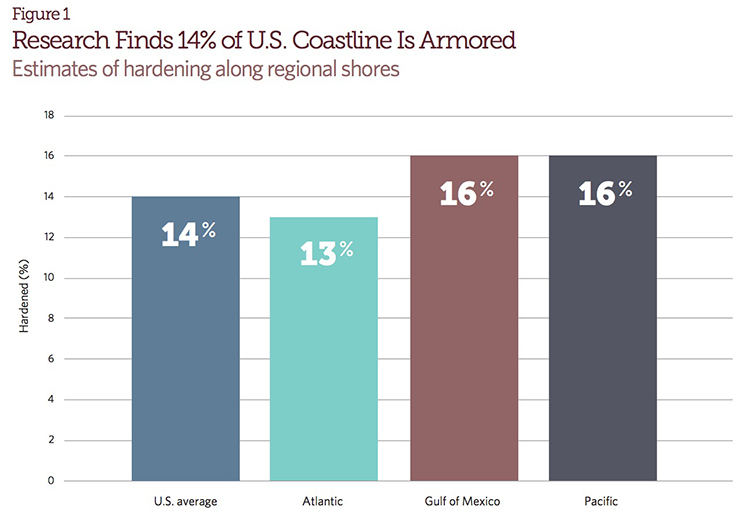PEW CHARITABLE TRUSTS
Natural stabilization techniques help reduce effects of erosion and habitat loss
Overview
People are drawn to places where land and water meet. More than 123 million people—39 percent of the U.S. population—live in “coastal shoreline” counties, those that are directly adjacent to the open ocean, major estuaries, and the Great Lakes, and as a result, often bear the brunt of extreme weather. The high concentration of people and property, combined with challenges such as erosion and sea-level rise, has led landowners to build infrastructure such as bulkheads or seawalls. This hardening of the shoreline, in turn, has caused loss of wetlands and natural habitats that people and nature rely upon.
Living shorelines, which use a range of natural stabilization techniques commonly involving the strategic placement of plants, stone, sand, and other materials, provide a proven and cost-effective alternative to structural approaches. These nature-based solutions prevent erosion along estuarine coasts, bays, sheltered coastlines, and rivers while maintaining the land-and-water connection important to sustaining habitats for fish and wildlife, filtering pollutants from stormwater runoff, and protecting land from wave energy.
An alternative to structural shoreline management
Experts are increasingly concerned about the expanding use and negative effects of seawalls and bulkheads along the shore, particularly coastal habitat loss and degradation. A recent analysis found that at least 14 percent, about 14,000 miles, of the nation’s tidal shoreline is already hardened. Without intervention, this figure is expected to grow.
However, property owners are also embracing more alternative, natural approaches to shoreline protection. Analyses of costs related to structural versus natural methods have found that living shoreline projects are often the less expensive and more durable option.5 For example, research in North Carolina determined that living shorelines outperformed bulkheads during Hurricane Irene in 2011. One key difference noted in the study is that structures can weaken and fail and must be replaced at full cost while living shorelines become stronger over time. The study found that 75 percent of regional bulkheads surveyed were damaged by the storm.
Barriers to implementing living shoreline projects
Every five years, the U.S. Army Corps of Engineers’ nationwide permit program reviews types of activities in streams, wetlands, and other waters and generally authorizes those deemed to have minimal adverse environmental effects. The Corps’ regulatory framework, however, has not kept pace with advances in natural shoreline management or scientific understanding of the cumulative harms of hardening. Existing permits that address bank stabilization and aquatic ecosystem restoration do not include most living shoreline activities, which face greater federal scrutiny and longer permit reviews than hard infrastructure projects.
Support for living shorelines
In 2016, the Corps will review and update the permit program. The Pew Charitable Trusts supports establishing a new nationwide general permit for living shorelines that will encourage the use of natural protections and level the playing field for living shorelines with other bank stabilization methods.
Download full version (PDF): Living Shorelines – A Key Line of Defense
About the Pew Charitable Trusts
www.pewtrusts.org
“The Pew Charitable Trusts is driven by the power of knowledge to solve today’s most challenging problems. We are an independent nonprofit organization – the sole beneficiary of seven individual trusts established between 1948 and 1979 by two sons and two daughters of Sun Oil Company founder Joseph N. Pew and his wife, Mary Anderson Pew.”







 RSS Feed
RSS Feed